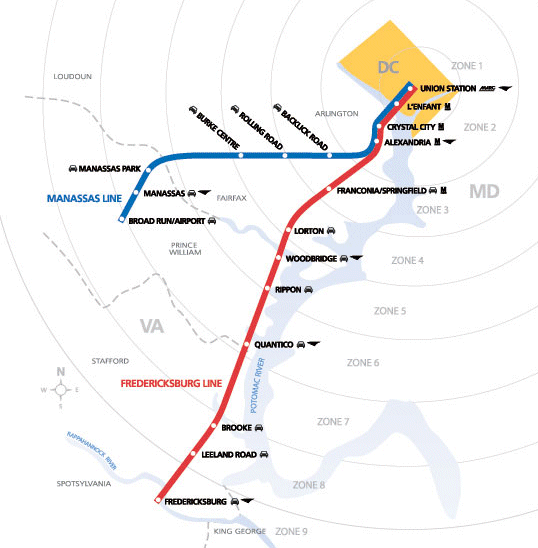
VRE tracks and stations now in service
Source: VRE
The Virginia Railway Express is the only rail transit system now serving Prince William County, other than intercity train service provided by Amtrak. Prince William has no light rail systems and no Metrorail stations.
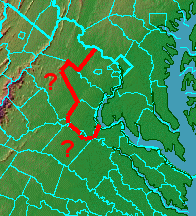 VRE started carrying passengers in 1992. The public rail transit system uses freight rail tracks owned by CSX to haul passengers from Fredericksburg to Union Station in DC, and tracks owned by Norfolk Southern to carry passengers from Manassas to Union Station.
VRE started carrying passengers in 1992. The public rail transit system uses freight rail tracks owned by CSX to haul passengers from Fredericksburg to Union Station in DC, and tracks owned by Norfolk Southern to carry passengers from Manassas to Union Station.
Passenger rail in Northern Virginia is not a money-maker for the CSX or Norfolk Southern. Since 1979, all passenger rail in Virginia has been managed and financed by government agencies. The private-sector railway companies are compensated (VRE pays CSX about $4 million/year for use of the track), but the freight rail systems don't seek expansion of passenger rail services.
The major expansion of track to accommodate VRE was the construction of a new bridge over Quantico Creek in 2006, providing two tracks at that crossing and eliminating a major bottleneck, plus a $12.5 million upgrade of the AF Interlocking in Alexandria (where the Fredericksburg and Manassas Lines converge). Other frieght rail options are being considered, but no new freight rail corridors have been established in Northern Virginia since completion of the RF&P in 1872. (The now-defunct extension of the W&OD to Great Falls was for passenger travel.)
VRE owns its own locomotives and over 60 train cars dedicated to commuter service, and contracts with Amtrak to provide the crews who operate the trains. (Union Station is a busy hub for Amtrak.) VRE is run as a partnership between the Potomac-Rappahannock Transportation Commission (PRTC) - including Prince William and Stafford counties plus the cities of Manassas, Manassas Park and Fredericksburg - and the Northern Virginia Transportation Commission (NVTC) - including Arlington, Fairfax, and Loudoun counties plus the cities of Alexandria, Fairfax, and Falls Church.
Local governments subsidize VRE operations. The public transit system is a money-loser, if you count only the fares paid by customers who use the trains. It's the non-users who carry roughly half of the financial load, subsizing operations through tax support from the local jurisdictions. The tax funding subsidizing VRE operations comes from the 5 counties and 6 cities managing VRE. Those jurisdictions have been authorized by the General Assembly to collect a 2% Motor Fuels Tax.
Notice who is missing from the jurisdictions that finance VRE? Residents of non-VRE jurisdictions get to ride the train, but only the counties/cities managing VRE are paying the subsidy. Pretty good deal for residents of Spotsylvania and Fauquier counties, eh?
The "freeloaders" in nearby counties do actually pay some of the VRE costs, through state taxes. The state provides some transit funding - about 2 cents of the state's 17.5 cents/gallon tax on gasoline ends up supporting transit projects.1 If VRE is expanded, or if current VRE jurisdictions can entice the neighbors into joining, then extra funding will be available for both capital (construction, locomotives, new cars) and operational costs.
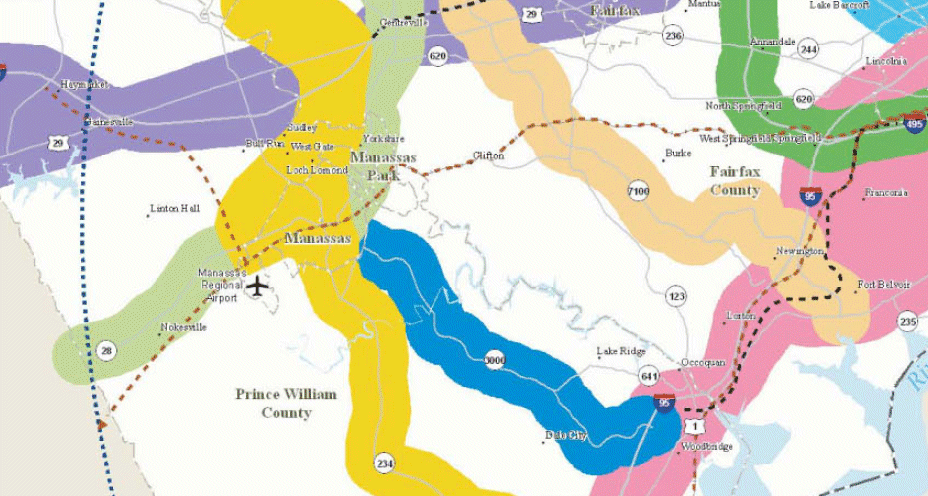
People buying gasoline and driving cars in VRE-member jurisdictions are paying a 2% extra tax so other people can ride the train. According to the Heritage Foundation in 2005, "When a passenger from Fredericksburg pays his or her $7.29 ticket (10-pass) to climb aboard the train, taxpayers kick in another $10.50 to finance that ride. And because morning riders come back in the evening, each Fredericksburg passenger imposes a daily cost of $21 on the community, the state, and the nation."2
Why hasn't this caused a political explosion?
Subsidizing VRE is politicallly acceptable because paying for trains are seen as a cheaper alternative than paying for more lane miles of asphalt/concrete for travel by car/bus. ("Lane miles" measure capacity of roads to move vehicles. A 1-mile stretch of 4-lane highway, and a 2-mile stretch of 2-lane highway, both have 4 "lane miles.") The Northern Virginia Transportation Commission claims VRE is now "carrying the equivalent ridership of at least two rush hour freeway lanes in the heavily congested I-66 and I-95/395 corridors."3 Simply expanding I-95 again, to make it an8-lane highway for the 6 miles between Springfield and the Occoquan River, will cost $123 million - $10 million per lane mile.
You don't need to live in Northern Virginia long to recognize that traffic here is a mess, and commuters are quite vocal in suggesting solutions. A common solution is "we need to extend Metro" and "we need to extend VRE." Often unspoken in those conversations is the phrase "...and if other commuters would take the train, I could continue to drive by myself but have less congestion on the road."
Metro may be extended to Prince William one day - getting Metro to Potomac Mills is included in the county's Futures Commission document and the NVTA's TransAction 2030 Plan (with a projected cost of only $1.5 billion. VRE expects to expand its capacity to carry passengers on existing routes - and to extend service to Haymarket in western Prince William County.
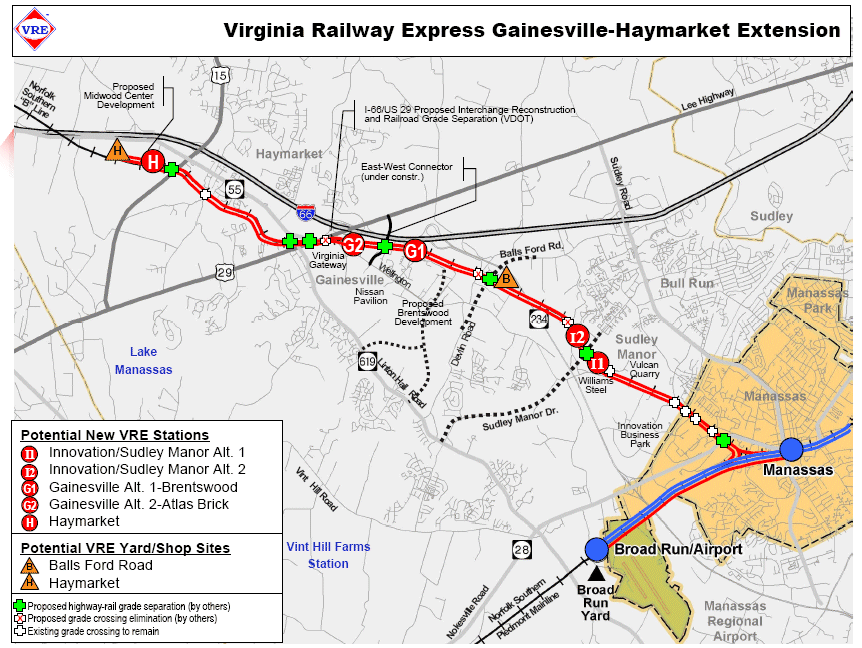
Every passenger carried by VRE is a person not driving on the highways, so VRE advocates highlight how funding for transit will reduce congestion on I-95 and other highways. The basic challenge is to direct transportation funding away from constructing new roads, or widening of existing roads, towards rail. VRE expansion requires purchase of new locomotives/rail cars, upgrades of rail signals, plus building/expanding stations and parking garages. Even trains need storage space, and VRE must build (or continue to pay for use of an existing) rail yard in DC to store trains between morning and evening runs, as well as expand overnight train storage at the ends of each line.
VRE expansion to Haymarket is much more likely to occur in our lifetime than extension of Metrorail service to Potomac Mills. The initial cost to extend VRE to Haymarket projected at only $200 million. Funding for that extension is a priority in various state and regional budget proposals. the proposed expansion is also a key factor in determining how western Prince William will develop. County officias are likely to approve "transit oriented develoment" projects, if developers show their proposals will reduce the constant increase in demand for more lane miles to satisfy additional commuters.
Norfolk Southern has existing infrastructure in place to support the VRE traffic, but is also planning to add a second track west of Haymarket so additional freight trains can travel between Manassas and the rail junction at Hagerstown, Maryland. The state is even considering building a new line between Culpeper and Manassas Gap, which would eliminate any conflicts between freight and VRE traffic east of Haymarket.
The historical pattern of the Orange and Alexandria and the Manassas Gap railroads still facilitate traffic towards Alexandria, just as existing interstates and Metro facilitate traffic from the periphery to the urban "hub." Freight rail lines do not make it easy to travel around the periphery, so freight shipped into the harbor at Norfolk can be carried by rail to Chicago. Building a new rail line for Norfolk Southern would involve acquisition of right-of-way and major construction. Political challenges by affected landowners and construction costs are likely to stand in the way of a Culpeper Cut-off (or the options in the east along the CSX, to reduce transport of hazardous cargo through DC).
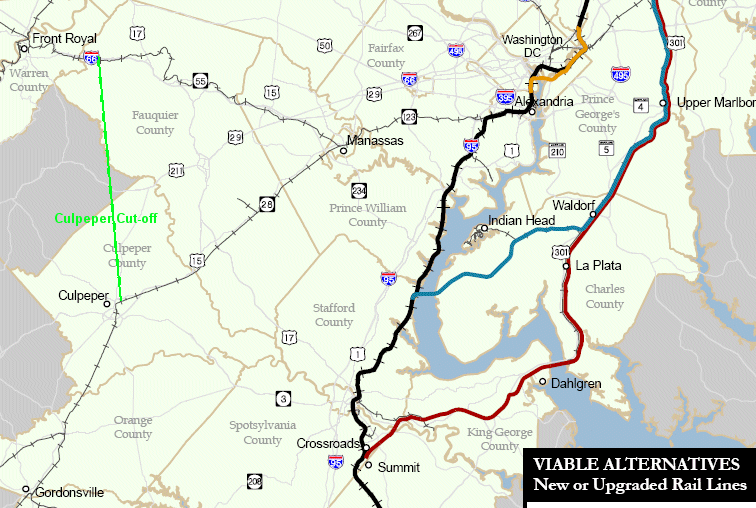
The exact locations of the 2-3 VRE stations on the Gainesville-Haymarket extension have not been determined. Two separate proposals for major rezonings to increase development potential near Gainesville have proposed locating one station east of the Route 29/Interstate 66 intersection. The Brentswood rezoning to build 6,800 houses just east of Gainesville and south of I-66, between Linton Hall Road and the Nissan Pavillion, was not pursued after strong negative response in 2006. Up to $50 million was proffered for a new VRE station, as part of that Brentswood project.
In early 2008, a new proposal to build north of I-66 was presented to county officials. The "Dominion Station" project on the Latsios property would resemble Reston Town Center, according to initial discussions.
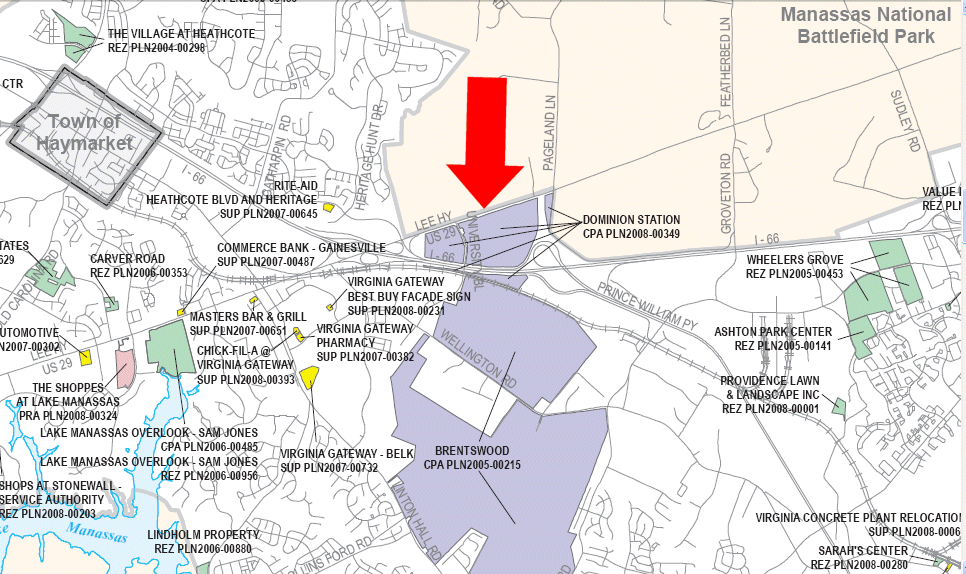
The project requires a pedestrian bridge over I-66 to access the proposed VRE station, since this time the property proposed for intense development is north of the interstate highway. The Dominion Station brochure still claims that almost all of the property will be within a 10-minute walk to commuter rail. This time, proffers for VRE construction are not so clear. The development brochure suggests the infrastructure could be funded through a private-public partnership of some sort, rather than just built by the developer.
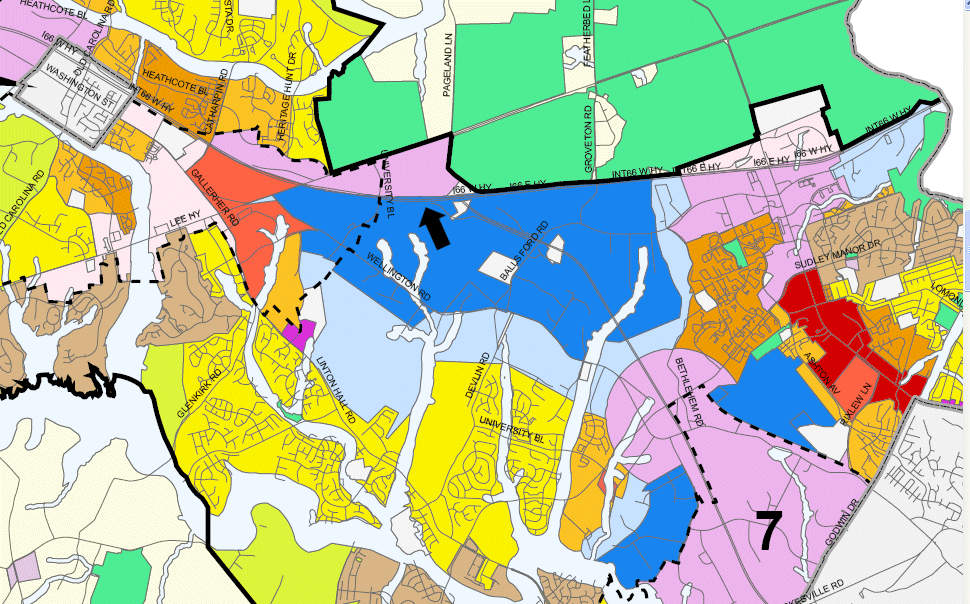
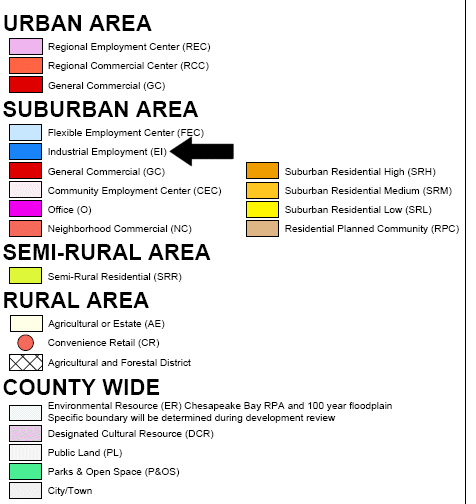
The VRE station is proposed for a section of the county that was planned for industrial development, rather than residents, retail, and offices. The county planned for massive amounts of industrial development near rail lines - but like Alexandria, Prince William is not developing as a manufacturing center. Instead, the county is shiftingfrom rural farms to suburbs, and strruggling to attract office development that would provide white-collar jobs to residents who are tired of commuting into Fairfax/DC. Rail transit is seen as solution, in part, to the congestion during commutes. Better yet, rail could stimulate "smart growth," where people live/work/play in a local area and do not need cars for all of their personal transportation.
One drawback: VRE is not two-way mass transit like Metro in the urban core of DC, or in Arlington County. VRE is a commuter rail line, hauling people in one direction in the morning, parking near Union Station, and returning back home in the afternoon. The extraordinary land use redevelopment stimulated by Metrorail in the Rosslyn-Balston corridor would be impossible to create at Gainesville/Haymarket, if the VRE rail transit was limited to a dozen or so trains going one way in just morning/afternoon rush hour.
The Dominion Station project will develop the "premium corporate office site" in Prince William County. The county envisions Gainesville developing into a Edge City comparable to Tysons Corner, thanks to the transportation infrastructure of I-66, Route 29, and the railroad. If developed as proposed, Dominion Station would create more jobs than it would add residents, a rare event for "mixed use" projects in Prince William.
Similarly, the proposed Wheeler Grove development at the next I-66 interchange closer to DC would create 57,000 square feet of retail, 1.5 million square feet of office, 772 multi-family dwelling units, and two hotels with a combined 290 rooms. However, Phase 1A would permit construction of 500 dwelling units and just 60,000 square feet of office (smaller than a modern Wal*Mart) in the first phase, and Phase 1B would permit 272 more residential units in exchange for construction of 78,000 square feet of additional office space and up to 57,000 gross square feet of retail space - with no guarantee that the remaining 1.4 million square feet of projected employment-oriented buildings would ever be constructed.
The county Planning Commission recommended that the Board of County Supervisors reject the Wheeler's Grove rezoning proposal, primarily over the lack of a "proffer" of a school site rather than the failure to ensure transit-oriented development of construction of the office buildings. The date for a final hearing of the Wheeler's Grove rezoning by the supervisors is now scheduled for April 2008. The elected supervisors make the final land use decisions for the county. The supervisors can accept/reject recommendations from the Planning Commission, which in Prince William consists of 8 people who were appointed by the 8 supervisors.
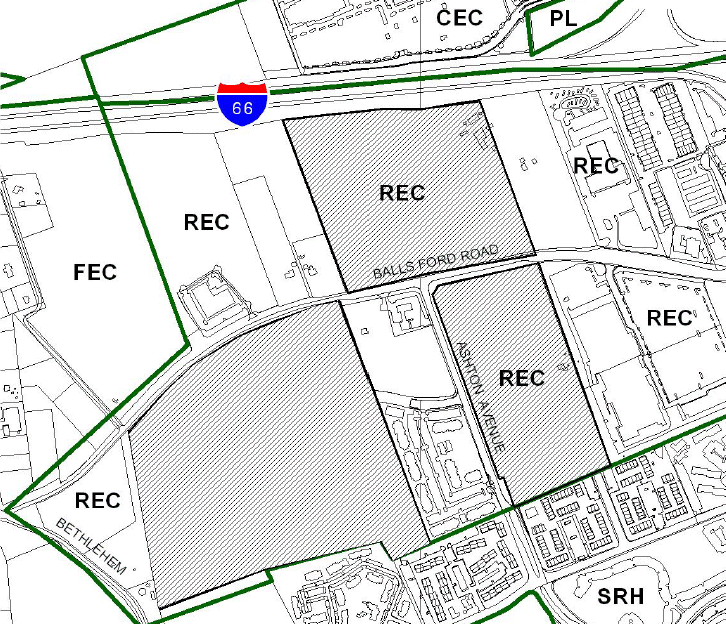
On page 5 of the VRE plan to extend service westward, note the gap between population growth and employment growth in western Prince William County. Countywide, for every resident there are only .3 jobs. In contrast to Fairfax County, most people commute out of Prince William to get to work.
The Dominion Station proposal would create 6,884 office jobs and 2,666 retail jobs, while adding only 4,950 more residents to the site... suggesting it really would be an employment center, if the office buildings were actually built.
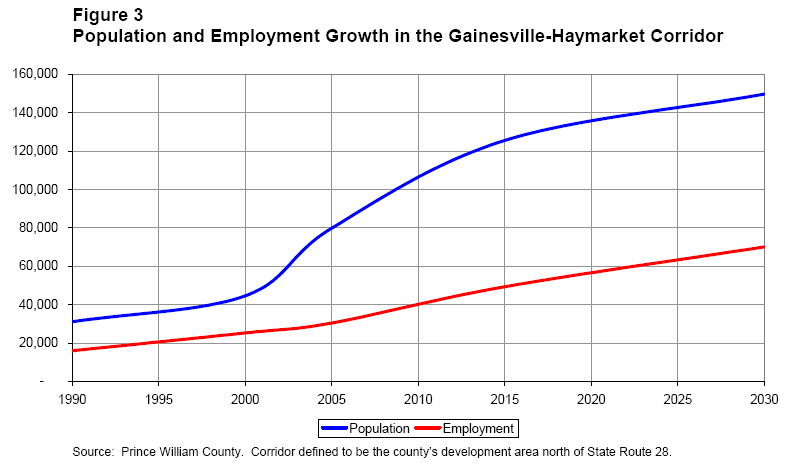
On p.12 of the Virginia Railway Express Gainesville-Haymarket Extension Implementation Plan, the case for a VRE station west of Haymarket includes "travelers to Washington from towns to the west would find it more convenient and fast to drive to Haymarket versus using a train station closer to home. Haymarket is situated where I-66 crosses US Route 15 and has excellent regional highway access. This will be the location that captures commuters from residential developments along the western edge of Prince William County's development zone, as well as from the north, west and southwest."
However, the same words could be cited as a reason to avoid building a VRE station west of Haymarket. Inviting Warren Country residents, including those living in Front Royal, to drive I-66 to Haymaket does not address the current transportation problem. It does not move current or future residents in Northern Virginia from suburban residences to jobs in the urban core. Instead, a train station at Haymarket might encourage further sprawl. A station west of Route 29 could invite Shenandoah Valley residents to drive on I-66 and take advantage of VRE, while the home jurisdictions would not contribute to the VRE operational subsidy.
Locating a VRE station in Nokesville would offer the same "drive to VRE" opportunity for Fauquier and Culpeper county residents, and everyone living near Route 29 all the way to to Charlottesville. The existing challenge of Spotsylvania/Fauquier County residents using VRE as "freeloaders" would be repeated. Investment in new transportation infrastructure, even rail stations, could exacerbate rather than mitigate the "disfunctional" land use pattern highlighted by Ed Risse.